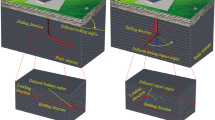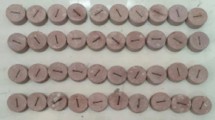In this paper, to study the failure characteristics and mechanical properties of slate and shale, the authors have conducted triaxial tests on shale and slate samples. To evaluate the peak stress and the destruction mode in the samples, the tests are performed on a triaxial rock-mechanical testing system. The experimental results show that compression would cause multiple cracks in shale. The cracks are characterized by a small width, and none of them are through cracks. When a slate sample is subjected to compressive failure, the developed cracks are characterized by a comparatively large opening, and some cracks are through. The compressive strength of shale is three times higher than the compressive strength of slate, and the Poisson’s ratio of shale is lower than that of slate. In the process of compressive failure of shale, the deformation is small, and the strain increases linearly along the direction of the principal stress. In the process of deformation of slate, the deformation is great, and the strain increase is divided into two stages – fast increase and slow increase. Comparison of mechanical properties of these types of rock with different lithology can provide important background for shale gas reservoir fracturing and slate foundation consolidation.



Similar content being viewed by others
References
B. Hu, J. Wang, and Z. Ma. “A fractal discrete fracture network based model for gas production from fractured shale reservoirs,” Energies, 13(7), 1857 (2020).
G. Ma, Y. Chen, Y. Jin, and H. Wang, “Modelling temperature-influenced acidizing process in fractured carbonate rocks,” Int. J. Rock Mech. Min. Sci., 105, 73-84 (2018).
Z. Wang, W. Fan, H. Sun, J. Yao, G. Zhu, L. Zhang, and Y. Yang, “Multiscale flow simulation of shale oil considering hydro-thermal process,” Appl. Therm. Eng., 08, 177 (2020).
X. Hao, X. Quansheng, Y. Dequan, W. Shaohua, and W. Yingnan, “Effect of bedding angle and confining pressure on the brittleness of geomaterials: a case study on slate,” Adv. Mater. Sci. Eng., 2019, 1-17 (2019).
L. Yang, W. Shuo, J. Qingping, Y. Yuan, and G. Jian, “Effects of microstructure and rock mineralogy on movable fluid saturation in tight reservoirs,” Energy Fuel., 34(11), 14515-14526 (2020).
X. Yan, S. Jing, and L. Dehua, “Numerical simulation of shale gas multiscale seepage mechanism-coupled stress sensitivity,” J. Chem., 2019, 1-13 (2019).
J. Chen, Y. Li, H. Ma, X. Wang, and S. Li, “Experimental study of shale triaxial compression considering the effects of fractures,” Sci. Technol. Eng., 20(26), 10778-10782 (2020).
Q. Li, M. Chen, and Y. Jin, “Experimental research on failure modes and mechanical behaviors of gas-bearing shale,” Chin. J. Rock Mech. Eng., 31(S2), 3763-3771 (2012).
C. Jia, J. Chen, and J. Guo, “Research on mechanical behaviors and failure modes of layer shale,” Rock Soil Mech., 34(2), 57-61 (2013).
P. Chen, Q. Han, and T. Ma, “The mechanical properties of shale based on micro-indentation test,” Pet. Expl. Dev., 42(5), 662-670 (2015).
Z. Deng, L. Cheng, and L. Pan, “Effect of bedding angle on shale triaxial stress, testing and velocity of P-wave and S-wave,” J. Northeast Pet. Univ., 42(5), 662-670 (2015).
C. Wang, J. Li, H. Lin, J. Liao, P. Wang, and S. Wang, “Anisotropic mechanical characteristics of slate in uniaxial compression,” J. Cent. South Univ. (Nat. Sci. Ed.), 47(11), 3759- 3764 (2016).
Y. Liu, H. Fu, Y. Wu, Y. He, and H. Dong, “Experimental study on Brazilian splitting of slate based on single-weak plane theory,” J. Chin. Coal Soc., 38(10), 1775-1780 (2013).
Y. Song, S. Lei, Z. Mao, C. Zou, and W. Zhang, “Experiment on the mechanical properties of carbonaceous slate under dry and saturated conditions,” Coal Sci. Technol., 42(10), 48-52 (2014).
T. Wen, H. Tang, Y. Liu, K. Wang, C. Yang, “Energy and damage analysis of slate during triaxial compression under different confining pressures,” Coal Geol. Pros., 44(03), 80-86 (2016).
C. Yang, H. Mao, X. Wang, X. Li, and J. Chen, “Research on the microstructure and mechanical properties of slate softening in contact with water,” Rock Soil Mech., 2006(12), 2090-2098 (2006).
A. Vachaparampil and A. Ghassemi, “Failure characteristics of three shales under true-triaxial compression,” Int. J. Rock Mech. Min. Sci., 100, 151-159 (2017).
B. Debecker and A. Vervoort, “Two-dimensional discrete element simulations of the fracture behavior of slate,” Int. J. Rock Mech. Min. Sci., 61, 161-170 (2013).
Author information
Authors and Affiliations
Corresponding author
Additional information
Translated from Khimiya i Tekhnologiya Topliv i Masel, No. 5, pp. 66–68, September-October, 2021.
Rights and permissions
About this article
Cite this article
Li, L., Yu, W., Zhang, X. et al. Comparative Analysis of Fracture Characteristics and Mechanical Properties of Shale and Slate Based on Triaxial Compression Test. Chem Technol Fuels Oils 57, 813–817 (2021). https://doi.org/10.1007/s10553-021-01311-1
Published:
Issue Date:
DOI: https://doi.org/10.1007/s10553-021-01311-1




